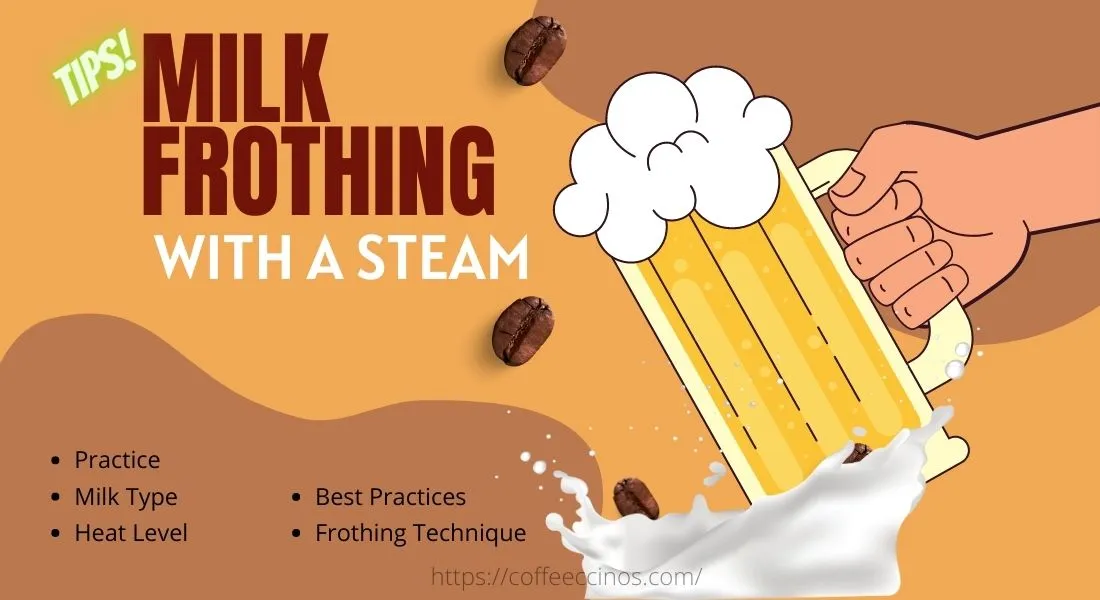How To Froth Milk With A Steam Wand-Milk Frothing Tips With a Steam Wand, Which Type Milk & Heat Level
How to froth milk with a steam wand is an interesting thing to learn. “Frothing” is the way toward making “microbubbles” in the milk which is ultimately used in espresso drinks like Latte and Cappuccino. actually milk frothing is done by separate milk frothers or an in built steam wand present in espresso machines adjacent to portafilter. This steam wand helps in frothing and steaming the milk for espresso based drinks.
Indeed, it might be difficult to get the entire milk to foam by any means, although the entire milk will have a creamier taste. Somewhat skimmed milk (2%) is suggested. It is not difficult to foam, and it will have a velvety taste. It is hard to get soy milk to foam, in spite of the fact that it tends to be finished. Frothed or foamed milk is utilized in numerous coffee drinks and other hot refreshments. With some training, you can make fabulous frothed milk for cappuccinos, macchiatos, tea lattes, and different beverages.

On the off chance that you put resources into a coffee machine with a steam wand, frothing milk with it is extremely simple. In fact, talking, the wand will steam your milk on the grounds that foaming it delivers an alternate surface in the air pockets, however both yield an entirely pleasant froth. Most current machines including numerous programmed machines have a steam wand that hangs off the side. This appended arm basically powers steam into your milk, tenderly warming it with pressure while adding air to the milk, which makes it froth. You will require a little metal pitcher for foaming.
These are called milk-foaming pitchers, and they are accessible at numerous stores that sell coffee machines and embellishments, yet they are additionally effortlessly found at online retailers. They are the ideal significance for the steam wand and the long handle isn’t hard to hold and control. The specific strategies for foaming milk shift somewhat dependent on the beverage, however, this method incorporates the essentials for this style of texturized milk. Your milk should be truly cold for the best outcomes. Before go further you should keep to know different between milk frother & milk steamer.
Ingredients
- 1/2 cup cold milk
Steps to Make It
- Accumulate the ingredients
- Pour the cold milk into a little metal pitcher.
- Spot the pitcher under the steam wand.
- Addition the steam wand into the milk, just beneath the surface. Draw in the steam yield dial to a constant flow of steam.
- Keeping the tip of the wand close to the side of the pitcher, making a vortex in the milk.
- Move the pitcher all over, and around the wand to join air into the milk and separate bigger air pockets. The air pockets ought to get continuously more modest.
- When the blend has expanded in size generously about twofold the volume for a cappuccino or 1/2 times the volume for a latte close the dial and eliminate the wand from the pitcher.
- Rapidly perfect the wand with a paper towel or clean kitchen towel so there are no milk drippings on your counter or floor.
- The surface of the milk ought to be smooth and comparative in appearance to liquefied frozen yogurt.
- Promptly empty the frothed milk into your espresso drink, leaving some in the pitcher to make latte workmanship whenever wanted.
5 Important Tips for Frothing Milk For Beginners
Focusing on manual steaming, yet in case you’re utilizing an auto-foaming wand, there’s a lot of data here for you too. Past that, on the most proficient method to get the best from auto-foaming steam wands.
Best Practices for Milk Frothing:
For this process, cold milk is recommended because it can give the best desired results. A few groups even store their pitchers in the cooler. For fill level, take a stab at going to simply underneath the where spout begins to shape. These size pitchers will get you around 5 or 6 ounces, enough for an enormous latte. In the event that that is excessive, you can go with less, however, you most likely would prefer not to add more as the milk will grow when foamed.
Before preceding to steam it, confirm that your machine has been warmed up to work out. This is particularly obvious with single evaporator machines, which can require a moment to arrive subsequent to flipping the steam switch. A smart way to make a machine produce some more steam when you realize how long it requires for the machine to will steam temperature you can begin steaming a couple of moments before the machine demonstrates it’s arrived at full temp. Doing that with many single heater machines will make the warming component stay on, creating more steam while you’re foaming.
On the off chance that you stand by until the machine shows it’s prepared, the component will most likely mood killer and quits producing steam while you’re foaming. That doesn’t work with every single heater, particularly those with thermoblocks, however, check it out with yours and you may get some additional steam power.
Other accepted procedures come down to what I’ll call cleanse, wipe, cleanse. Cleanse your wand preceding steaming to eliminate any water that is in the steaming circuit. At that point when you’re finished foaming, utilize a towel to wipe your wand before the milk gets an opportunity to heat on. At that point, cleanse once more. The last cleanse is vital. At the point when you wrap up steaming the tip is as yet in the milk. Then the wand cools down the milk, is then purifying and the milk will come out.
- To begin with, let us take a pitcher marked with 12 oz on it
- Utilize cold milk and a cool pitcher.
- Cleanse the wand preceding steaming.
- Wipe and cleanse again following steaming.
Heat Level:
The heat level of the milk plays an important role while steaming. So the entire thought behind foaming milk is making a sweet, rich surface. Warming milk builds its obvious pleasantness, however just to a point. Presently, in case you’re more current to drain-based coffee drinks, you may be anticipating that a temperature closer should a customary trickle-style espresso machine. That ought to never be the situation.
Milk is at its best from 135-150°F. That is 57-66°C. As you go more blazing, you lose the pleasantness. In the event that you go excessively hot, you’ll sing the milk. In the case of utilizing a thermometer, know about slack. When you are holding the pitcher to feel its temperature and at some point, it gets unbearable to hold more. So when you get the desired temperature, it is better to turn off the steam. So that is the point at which you need to cut the steam.
Frothing Technique:
The frothing procedure is tied in with tracking down the appropriate steam tip position comparative with the outside of the milk. Less milk in the pitcher that only covers the bottom surface will not have much steam. Excessively high and you’ll either get a lot of air in or make a major wreck. So the thought is, to begin with, the steam tip just beneath the outside of the milk. At that point change the profundity so you hear a periodic tear, which demonstrates modest quantities of air being sucked into the milk.
Presently, regardless of whether you need a super-fine miniature froth for a latte or an airier foam for a customary cappuccino, the beginning of the cycle is something very similar. You need to get tears of air in quickly. Cold milk will absorb more air than the hotter one. For a fine latte foam, all air ought to be in when the outside of the pitcher begins to warm. By then you position the wand a hair more profound into the milk and discover a tip position and point which makes the milk roll.
That move assists break with increasing any bigger air pockets and blends the milk to make a uniform surface through the pitcher. In the wake of steaming, in the event that you discover you have some bigger air pockets, you can thump and whirl the pitcher a couple of times to help separate and blend those.
- Start with the tip just underneath the surface.
- Change tip position to hear infrequent tears of air into the milk.
- For a latte get the entirety of the air in when the outside of the pitcher begins to warm.
- For airier foam keep adding air.
- At the point when all air is in, discover a tip position and point which roll the milk and keep moving to conclusive temp.
- When the tip is still in the milk, turn off the steam, and take it out by swabbing. Thump and whirl the pitcher, if necessary, to dispose of enormous air pockets if necessary.
Milk Type:
In a subsequent, I’ll get to how you can rehearse this with milk types and appraisals dependent on our foaming, pouring, and trials. Some prominent outcomes: entire fat dairy milk is the best quality level. It scored 5/5 in foaming, pouring, and taste for 15 focuses complete. Our dairy milk second place was an astonishment. Lactaid milk is best suitable for it. Our analyzers truly preferred the pleasantness of the Lactaid milk.
Practice:
Thus, you truly need to improve your foaming abilities or practice latte craftsmanship. Indeed, here’s the manner by which you can do it the entire day without utilizing any milk or coffee. Instead of milk, you can take some plain water and one to two drops of a dishwasher. That mix carries on almost indistinguishably from milk when foamed. You can watch the below video to learn everything through visuals.
Frequently Ask Questions (FAQ’s)
1. Would I be able to Froth Milk Without a Steam Wand?
On the off chance that you don’t have a coffee machine or yours doesn’t have a steam wand, you can froth milk in a couple of various ways, yet expect that the air pockets will not be just about as fine and tight likewise with a steam wand.
2. Which Milks Gives the Best Froth?
In spite of regular conviction, full-fat milk doesn’t yield the best froth. Although smooth and velvety, the fat burdens the air pockets of air, and what you get isn’t pretty much as close and pressed as what you’d get if utilizing the best milk for coffee refreshments: non-fat or skim milk.
3. Is steamed milk and frothed milk something similar?
Frothed milk has more volume, with critical measures of froth. Steamed milk is warmed and all the more gently circulated air through, creating modest quantities of microfoam. Steamed milk is likewise more generally utilized in an assortment of espresso drinks, while foamed milk loans itself explicitly to froth-filled refreshments.
4. Would you be able to froth milk by hand?
Warmth milk. Utilizing a hand blender, whisk the milk until it arrives at the ideal foaminess. This technique makes somewhat preferred froth over racing by hand.
5. What would I be able to use rather than a frothing pitcher?
Practically any compartment that has a handle, can endure warmth, and it’s genuinely profound. A large espresso cup will work. Any tall glass cup will do. Milk will warm up and you will feel with your hands when is an ideal opportunity to stop.
![How to Clean Espresso Machine [Ultimate Cleaning Guide]](https://caffecionos.com/wp-content/uploads/2021/05/How-to-Clean-Espresso-Machine-768x394.png)


![How to Make Flat white Nespresso [Step-by-Step] Guide](https://caffecionos.com/wp-content/uploads/2021/04/How-to-Make-Flat-white-Nespresso-768x394.png)

